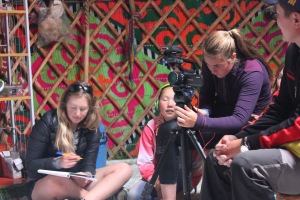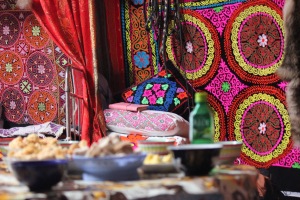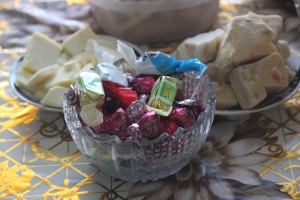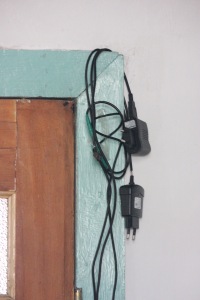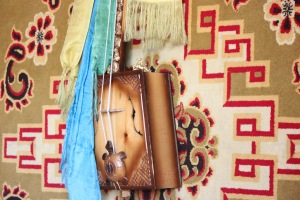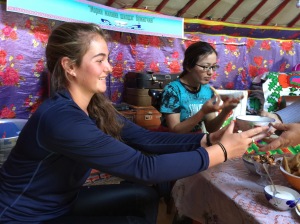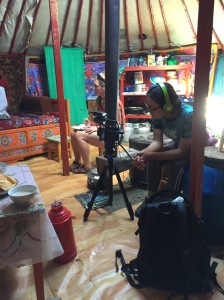


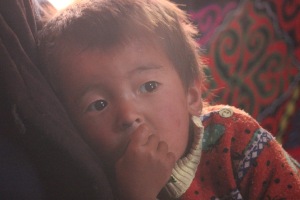






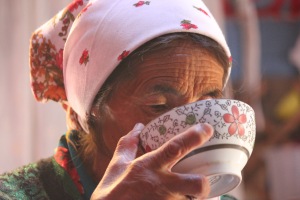



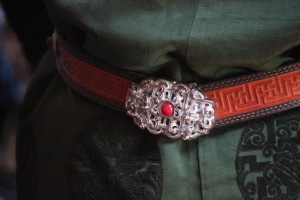

Today was an amazing day! After packing up camp, we trekked out to the homes of two Kazakh eagle-hunting families. Officially protected by UNESCO, falconry has been practiced by Kazakh nomads in this part of the world for thousands of years. Ghengis Kahn supposedly had over 5000 eagle hunters in his personal guard. Today, this form of hunting is still practiced by Kazakh and Kygryz peoples, including refugees living in Bayan-Olgii, Mongolia and Xinjiang, China. During the winter months, nomadic families in Bayan-Olgii hunt with Golden Eagles for fox and hare, using the fur for hats, and clothing. Each October, the Golden Eagle hunters (there are only approximately 400 of them left in the world) hold a festival in Bayaan Olgii, turning out in richly embellished dress, mounted on elaborately groomed horses, to demonstrate their skill.
When we entered the gers of these two eagle hunting families we were astounded by the ornate decorations that covered the interior. The standard Mongolian gers we had visited previously, had low ceilings and simple interiors, but these Kazakh gers were tall and intricately-embroidered inside. Bright oranges, various shades of red and green, and magenta adorned the walls. Almost neon-colored rugs overlapped one another on the floors and had been hand-embroidered by the women we interviewed. Fur hats, animal hides, eagle-hunting certificates, family photographs, and tufts of owl feathers hung from the walls. The first Kazakh family had a separate kitchen ger, not the now familiar hearth in the middle of their home like other Mongolian families we had visited.
It was fascinating to learn how these two women defined themselves. Because they live in Mongolia, they said, they think of themselves as Mongolian first rather than identifying with their Kazakh ethnic heritage. They both said that there was no difference between Kazakh women and Mongolian women except for the fact that they spoke different languages.
One of our standard interview questions was, “What does it mean to be beautiful?” When we asked this question to other Mongolian women, most all of them spoke about “inner beauty” saying that beauty was a reflection of the spirit within, and that every woman was somehow beautiful in her own way. However, when we asked these ethnic Kazakh women about their definition of beauty, both spoke of external beauty. They talked about eye-shape, long hair, and beautiful smiles. Physical beauty was important to them and their answers reflected their lifestyle. Their homes, so carefully decorated, exhibited a pride in aesthetics. These Kazakh families cared about appearance. Ornamentation and material things were clearly valued.
We left these two Kazakh women to complete one more interview nearby before packing up for the day. The next woman we spoke with was excited to be interviewed on-camera and got all dressed-up in traditional Mongolian finery to talk to us. She was a schoolteacher and talked about the importance of education. Like the other teacher we had interviewed, she also thought the use of technology in schools enhanced opportunities for all. At the end of her interview, she wanted to sing a traditional Mongolian “long song” for us. The ancient tradition of Mongolian “long song” is named such, not only because of the duration of the singing (sometimes as long as 5 or 10-minutes) but also because each syllable of the words sung is exaggerated and extended. A five-minute performance might consist of only ten words. The “long song” is meant to reflect the tranquility of the Mongolian soul and the words often depict the mountainous landscapes in which they are sung. This woman told us she had won many “long song” competitions and wanted to share her skill with us. Closing her eyes, she started singing. The melody was slow and meditational. Within seconds the entire room was transported to another place. It was exquisite.
After saying goodbye, we got into our jeep and headed East in search of a particular eagle hunting family. We wanted to find the family of a fourteen-year-old girl named Ashol Pan, the daughter of a prominent eagle hunter in the area. Ashol Pan’s image was shared internationally on social media a couple of years ago after she was photographed by Israeli photographer, Asher Svidensky who had embarked on a journey to photograph the Kazakh eagle hunters. Svidensky’s photographs made headlines back in 2014, but little has since been written about the eagle hunters he found and especially, the young woman he followed through the mountains.
When we finally arrived at Ashol Pan’s family ger it was getting dark and we were greeted, as always, with milk tea and curd. The family helped us set up our tent. We gave all the children pens and paper, and they sat on the ground and drew pictures around us while we cooked our dinner. After a meal of canned vegetables, rice and seaweed all stewed together, we joined in a game of pickup basketball (we were by far the worst players!) and played duck-duck-goose with the little children until the sun went down. It was a truly special end to an equally special day.


















